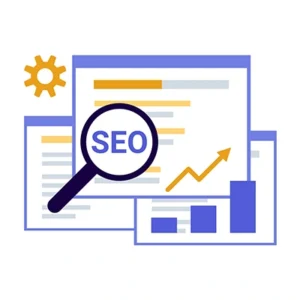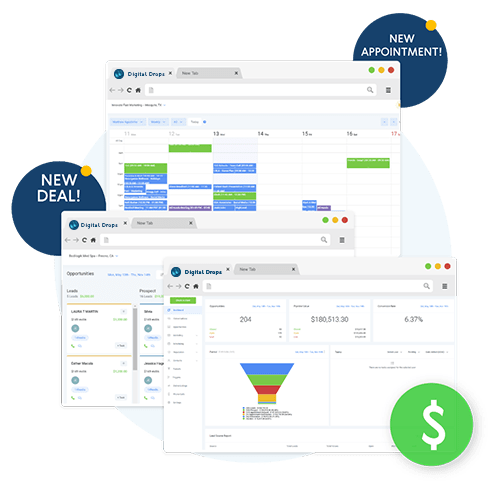Lead Generation Strategies for Maximum Impact
Digital marketing covers a wide range of strategies that businesses can leverage to achieve their marketing and sales goals. One key area of focus is advertising. When done correctly, advertising can be an extremely effective way to generate leads, increase sales, and find new customers. However, each digital platform has its own strengths and weaknesses. As a result, it's important to adopt different strategies that align with the functionality of each platform. Business
What is a lead?
In marketing, a lead is any person or organization that expresses interest in your products or services. It is important to have a successful strategy for nurturing and converting leads into customers, as this can make all the difference between success and failure for your business.

What is lead generation?
Lead generation is the process of generating interest in your product or service among potential customers. It consists of a variety of strategies designed to capture leads and convert them into paying customers.
Lead generation strategies include creating content such as blogs, videos, and webinars that attract potential customers; using social media platforms to reach new audiences; networking with influencers; using paid search and other marketing tactics to drive traffic to your website; and optimizing lead capture forms for higher conversion rates.
With effective lead generation strategies, you can significantly increase your sales pipeline and maximize success in the long run.
Lead generation is key to a successful business.
Lead generation is an essential part of any successful marketing strategy. Lead generation activities help you identify and connect with potential customers that have the highest chance of converting into paying customers. Lead generation also helps build relationships with current and prospective customers, enabling a deeper understanding of their needs and preferences. Lead generation strategies also help to increase brand exposure, strengthen brand loyalty.

What makes Lead Generation different from other marketing techniques?
Lead generation is different from other traditional marketing techniques because it focuses on attracting potential customers in the early stages of their buying journey, when they are just starting to research products or services. This means that you can capture leads before they make a purchase decision and nurture them with content throughout the entire process. As opposed to traditional marketing techniques such as advertising which only target people who may be ready to buy, lead generation helps you to reach out to a much larger audience, build relationships with leads, and convert them into customers. Also, it allows you to track the performance of your campaigns so that you can refine your strategies for maximum impact.

Types of lead generation.
Lead generation strategies vary depending on specific objectives, target audience, budget, and more.

Pay-per-click (PPC)
Campaigns involve bidding on keywords and phrases to increase visibility in google search and draw in leads.

Social media platforms
Lead generation also involves using social media platforms to connect with potential customers and build relationships.

Search engine optimization (SEO)
Focuses on improving website google seach visibility by appearing higher in search engine rankings.

Email Marketing
Involve sending targeted messages to potential customers to encourage them to take action.

Content marketing
Involves creating content that is valuable to potential customers and sharing it across various channels.

Webinars
Virtual events designed to engage potential customers and provide them with useful information about a product or service offering.
Lead generation is one of the most important aspects of any successful business. Digital Drops can help you create a system that will bring in more leads than you ever thought possible.
Our Lead generation tools include a CRM platform, designed to capture leads automatically and track them in one place. We offer features such as contact form builder, lead tracking, analytics, automated email campaigns, marketing automation tools, and more.
Our platform helps business owners and marketers easily collect data from potential customers and convert that information into sales leads. Also help identify qualified leads, automate follow-up processes, and measure performance to determine the effectiveness of lead generation strategies. Our lead generation systems provide businesses with a streamlined way to capture, track, and manage leads in one place.
Tips for successful lead generation campaign

Identify your target audience
To ensure successful lead generation, it is important to identify your target audience and tailor your strategies accordingly.
Set Lead Generation Goals
Establishing realistic goals helps you measure success and adjust if needed..
Utilize Lead Scoring
Lead scoring helps you prioritize leads based on their likelihood of converting into customers.
Leverage Automation
Lead generation systems and automation tools can help streamline processes and free up time for more strategic activities.
Monitor Lead Quality
Lead quality is just as important as quantity when it comes to successful lead generation. Regularly monitor the leads you generate to ensure they are of a high caliber.
Track Lead Sources
Tracking lead sources helps you determine which strategies are most effective and make the necessary changes.
Analyze Performance
Re-Engage old Leads
Provide Value
Lead generation strategies should always offer value to potential customers in order to be successful.
Personalize Content
Customizing messages for individual leads helps build trust and loyalty, increasing the chances of conversion.
Lead generation strategies
Lead generation strategies are an essential part of any successful business. Lead generation involves identifying, targeting, and engaging potential customers to increase sales and revenues. It requires a thorough understanding of customer needs and preferences as well as effective tactics for capturing leads. Effective lead-generation strategies use multiple channels such as email campaigns, SEO, content marketing, webinars, social media platforms, and PPC campaigns to reach potential customers. When used correctly, lead generation strategies can significantly increase the number of qualified leads for any business.
With the right approach and tools, businesses can generate leads more efficiently and cost-effectively, helping them grow their customer base and achieve success.
Lead generation process
The lead generation process involves identifying potential customers, building relationships with them, and providing useful information about a product or service offering. Lead scoring helps prioritize leads on their likelihood of converting into customers.
Lead generation systems help marketers easily collect data from potential customers and convert that information into sales leads. Lead generation strategies may also include social media platforms for connecting with potential customers, email marketing campaigns, and more. Lead generation is an ongoing process that requires careful planning and execution for successful results.
Who should lead generation in your business?
Lead generation should be the responsibility of a dedicated team or individual. This team or person will be responsible for executing lead generation strategies, tracking results, and analyzing performance. Lead generation requires expertise in areas such as marketing, sales, customer service, data analysis, and automation tools. Your business may choose to outsource this function to an expert in the field. Lead generation is an essential part of growing your business, so it is important to have the right team or individual in place for successful results.
Lead generation is a critical component of any successful marketing strategy. Businesses must invest time and resources into lead generation in order to maximize their ROI. With the right strategies and tools in place, businesses can capture quality leads and convert them into sales.
By leveraging lead scoring, automation, tracking, analysis and personalization, businesses can generate quality leads consistently. Lead generation is an ongoing process that requires careful planning and execution for successful results.
Why is lead generation important for brands?
Lead generation helps brands build relationships with potential customers, providing them with valuable information about their products and services. Lead generation enables brands to track leads, measure performance, and refine strategies for better results in the future. Lead generation also helps generate interest in products or services by emphasizing their value, increasing the likelihood of conversion. Lead generation is an essential tool for building brand recognition and trust and should be given the resources and attention it deserves to ensure success.
How to Qualify a Lead?
Qualifying a lead is an essential step in the lead generation process. Lead qualification helps you determine whether a potential customer is ready to buy, thus helping you prioritize leads and focus on those with better conversion potential. Lead qualification involves several steps, such as gathering information about the lead’s interests, needs, budget, timeline, and more. Lead qualification should also include checks for spam, duplicate contacts and other errors that could lead to a poor customer experience.
By qualifying leads, you can distinguish the most promising prospects from those who may not be ready to make a purchase. Lead qualification is an important step in the lead generation process and should be done with care to ensure successful results.

How can I identify quality leads?
Identifying quality leads is an essential part of successful lead generation. Quality leads are those who have a higher likelihood of converting into customers. Lead scoring is one tool that can help you identify quality leads. Lead scoring involves assigning points to leads based on their attributes and activity, such as demographics, behavior, and engagement with your brand. Lead scoring can help you prioritize leads and focus your efforts on higher quality contacts. Lead segmentation is another key tool in identifying quality leads. Lead segmentation allows you to divide your prospects into different groups based on shared attributes, such as industry, location, or job title. By segmenting your leads, you can target the most promising prospects for conversion.

What are marketing qualified leads (MQLs)?
Marketing qualified leads (MQLs) are prospects that have engaged with your brand in some way, indicating they may be interested in your products or services. MQLs are typically identified through lead scoring, which uses criteria such as website visits, content downloads, and social media interactions to determine interest levels. Once a prospect is marked as an MQL, they can be passed to the sales team for further qualification and follow-up.
What are sales-qualified leads (SQLs)?
Marketing qualified leads (MQLs) are prospects that have engaged with your brand in some way, indicating they may be interested in your products or services. MQLs are typically identified through lead scoring, which uses criteria such as website visits, content downloads, and social media interactions to determine interest levels. Once a prospect is marked as an MQL, they can be passed to the sales team for further qualification and follow-up.
What are sales-qualified leads (SQLs)?
Sales-qualified leads (SQLs) are prospects that have been identified and qualified by the sales team. SQLs typically come from MQLs, as they are more likely to convert into customers than other leads. The sales process may involve additional steps such as gathering information about the lead’s interests, needs, budget, timeline, and more. This process helps the sales team determine whether a potential customer is ready to buy and prioritize leads with better conversion potential.
What’s the Difference Between MQLs and SQLs?
MQLs (marketing qualified leads) and SQLs (sales qualified leads) are both types of prospects that have been identified as potentially interested in a company’s products or services. The main difference between the two is that MQLs are identified through lead scoring, based on criteria such as website visits, content downloads, and social media interactions. SQLs, on the other hand, are identified and qualified by the sales team through additional steps such as gathering information about the lead’s interests, needs, budget, timeline, and more. By focusing their attention on MQLs and SQLs, businesses can prioritize leads with higher conversion potential and save time by avoiding leads that are unlikely to buy.
What are product-qualified leads (PQLs)?
Product-qualified leads (PQLs) are prospects that have shown interest in a company’s product and are ready to move further down the sales funnel. PQLs typically come from SQLs, as they have already been qualified by the sales team and are more likely to convert into customers. The process of qualifying PQLs involves gathering detailed information about the product, such as features, pricing, and usability. By focusing their attention on PQLs, businesses can prioritize leads with better conversion potential and save time by avoiding leads that are unlikely to buy.
What is Lead Scoring?
Lead scoring is a process used to determine a lead’s likelihood of becoming a customer. Lead scoring assigns points to contacts based on criteria such as website visits, content downloads, and social media interactions. By assigning points to each contact, lead scoring helps businesses identify which leads are most likely to buy, allowing them to prioritize those prospects with higher conversion potential. Lead scoring can also be used to determine whether a lead is a marketing-qualified lead (MQL) or a sales-qualified lead (SQL). This helps businesses ensure they are focusing their attention on the right leads and saving time by avoiding leads that are unlikely to buy.
What is Lead Nurturing?
Lead nurturing is a process used to nurture prospects through the sales funnel. It involves sending targeted emails and other content to leads to keep them engaged and move them further down the funnel. Lead nurturing processes can involve email campaigns, social media posts, webinars, events, and more. By following up with prospects through lead nurturing, businesses can increase their chances of converting a lead into a customer.
What are service-qualified leads?
Service-qualified leads (SQLs) are prospects that have been identified and qualified by the service team. SQLs typically come from MQLs, as they have already been identified through lead scoring. The service process may involve additional steps such as gathering information about the lead’s interests, needs, budget, timeline, and more. This process helps the service team determine whether a potential customer is ready to move further down the sales funnel. By focusing their attention on SQLs, businesses can save time by avoiding leads that are unlikely to buy.
How can I attract high quality leads?
Attracting higher quality leads is an important step in the lead-generation process. Lead magnets are a great way to attract quality leads. Lead magnets are offers that provide value, such as free ebooks, whitepapers, or discounts for products or services. Lead magnets should be tailored to your target audience and their interests. Another effective way to attract quality leads is through targeted content. Content marketing allows you to create and share content that speaks directly to your target audience, helping to build relationships with them and draw them into the sales funnel. Social media can also be used to attract quality leads by engaging with potential customers on platforms such as LinkedIn or Twitter. Lead generation is a powerful tool for businesses, and investing in strategies to attract quality leads is essential for success.

Tell me the features of lead generation CRM software.
Lead generation CRM software is designed to help businesses capture, organize, and nurture leads in order to maximize conversion rates. Our platformot includes features such as contact management, lead scoring, automated marketing campaigns, email list segmentation, analytics tools, and more.

Advantages and disadvantages of lead generation.
Advantages of lead generation include increased conversion rates, lower cost-per-lead, more qualified leads for sales teams, and better customer segmentation. Additionally, lead generation helps businesses capture more high-quality prospects, grow their brand awareness, and reach a larger audience.
Disadvantages of lead generation include the potential for low-quality leads if the targeting is not done correctly and not having a system that automates sales and marketing tasks. . Additionally, it can be difficult for sales teams to nurture leads to move them further down the funnel.
Contact us for Lead Generation and CRM Automation Service!
Take the first step to growing your business today! Sign up for our lead generation program and take advantage of exclusive offers, targeted content, and personalized customer service. Start building relationships with qualified leads now and increase your conversion rate! Join us now and start generating more leads than ever before. Act now to get started!
FAQ
What is the lead generation process?
The lead generation process involves identifying potential customers, gathering information about them, qualifying the leads, and nurturing them until they become sales-ready. Lead generation should be done with a customer-centric approach to ensure successful results. The process includes creating offers that provide value to your target audience. Lead magnets such as free ebooks or discounts can be used to attract potential customers. Lead qualification involves gathering information about the lead’s interests, needs, budget, timeline, and more. Lead nurturing involves delivering content that is tailored to the customer’s needs and interests in order to draw them into the sales funnel. Lead generation should be data-driven and consistently monitored in order to ensure success.
What are lead generation examples?
Lead generation examples include the use of lead magnets such as free ebooks or discounts, targeted content marketing, engaging with prospects on social media platforms like LinkedIn or Twitter, and more. Lead generation can also involve using landing pages to capture more information from leads. Lead magnets should be tailored to the target audience’s interests in order to maximize conversion rates. Lead scoring is another key tool in lead generation, which assigns points to leads based on their attributes and activity in order to prioritize them. Lead segmentation is another tool that divides prospects into different groups based on shared attributes such as industry or job title. Lead generation should be regularly monitored and data-driven to ensure successful results.
Which are the 4 steps of the lead generation process?
The lead generation process involves four key steps: identifying potential customers, gathering information about them, qualifying the leads, and nurturing them until they become sales-ready. Lead identification should involve researching target markets and creating offers that provide value to attract prospects. Lead qualification involves learning more about prospects’ interests, needs, budget, timeline, etc.
What are lead generation and its types?
Lead generation is the process of identifying potential customers, gathering information about them, qualifying the leads, and nurturing them until they become sales-ready. Lead generation can be done through various types of strategies such as content marketing, email campaigns, social media engagement, lead magnets (free ebooks or discounts), landing pages, SEO optimization, pay-per-click advertising, and more. Lead generation should be done with a customer-centric approach to ensure successful results. Lead magnet offers should be tailored to the target audience’s interests in order to maximize conversion rates. Lead scoring is another key tool in lead generation, which assigns points to leads based on their attributes and activity in order to prioritize them. Lead segmentation is another tool that divides prospects into different groups based on shared attributes such as industry or job title. Lead generation should be regularly monitored and data-driven to ensure success.
What are the benefits of lead generation?
Lead generation helps organizations increase their sales pipeline, build relationships with potential customers, and convert leads into customers. Lead generation can also help organizations generate more inbound leads, measure the effectiveness of different campaigns, identify potential customers, and build trust with prospects. Lead generation should be done with a customer-centric approach to ensure successful results. Lead magnets such as free ebooks or discounts can be used to attract potential customers. Lead qualification involves gathering information about prospects in order to prioritize them and nurture them until they become sales-ready. Lead scoring is another key tool in lead generation, which assigns points to leads based on their attributes and activity in order to prioritize them. Lead segmentation is another tool that divides prospects into different groups based on shared attributes such as industry or job title. Lead generation should be regularly monitored and data-driven to ensure success. Lead generation is a powerful tool that can help organizations increase their sales pipeline, build relationships with potential customers, and convert leads into customers.
How can I improve my lead generation results?
Improving lead generation results can be achieved by setting clear goals and objectives, creating a comprehensive lead generation plan, employing customer-centric strategies, developing effective lead magnets, optimizing landing pages for conversions, using data to drive decisions, leveraging social media platforms to engage with customers, and monitoring leads regularly.
What are some common lead generation objections?
Common lead generation objections include lack of trust, lack of understanding about the product or service, fear that the product won’t meet their expectations, feeling overwhelmed by too much information, and not having enough time. To address these objections, it is important to build relationships with prospects so they can understand your brand better and offer personalized solutions tailored to their needs. Additionally, providing relevant and useful content can be a great way to establish trust with the customer and increase their confidence in your brand. Finally, it is helpful to show how your product or service can help the customer save time or money.
How do I overcome lead generation objections?
Overcoming lead generation objections requires building relationships with prospects, providing useful and relevant content to establish trust, offering personalized solutions tailored to their needs, and showing how your product or service can help the customer save time or money. Additionally, businesses should be more empathetic and patient when dealing with customers’ objections in order to build a strong and lasting relationship. Finally, businesses should have a comprehensive lead generation plan in place as well as good customer service to ensure successful lead conversion.
What is a lead magnet?
A lead magnet is a free offer such as an ebook, discount code, or webinar that businesses distribute to prospects in exchange for contact information. Lead magnets help attract more leads and increase the chances of successful lead conversion. When used correctly, they can help generate more qualified leads, build relationships with customers, and establish trust in your brand.
What are the best lead magnets?
The best lead magnets are those that are tailored to the target audience and provide real value. Examples of effective lead magnets include ebooks, checklists, webinars, discount codes, quizzes, videos, and templates. When selecting a lead magnet to use in your campaign it is important to consider the interests of your target audience as well as the goal of your campaign. Additionally, potential lead magnets should be tested to determine which offer best resonates with customers.
How do I create a lead magnet?
Creating a lead magnet involves researching the target audience, determining the goals of your campaign, and selecting an offer that adds value to customers. Additionally, it is important to create high-quality content that can engage prospects and build relationships. When creating content for the lead magnet, consider the interests of your target audience as well as the goal of your campaign. Finally, it is important to test potential lead magnets to measure effectiveness and determine the best offer to use in your campaign.
What are some tips for optimizing a landing page for conversions?
Some tips for optimizing a landing page for conversions include: creating an attention-grabbing headline, adding visuals such as videos or images, using concise copy that communicates the value of the offer, creating multiple call-to-action buttons to make it easier for customers to take action, and using customer testimonials or case studies to showcase the success of others. Additionally, businesses should use A/B testing to determine which elements are performing best and optimize accordingly. Finally, businesses should segment forms and landing pages to ensure that customers are not overwhelmed with irrelevant content.
What is lead nurturing?
Lead nurturing involves building relationships with prospects by providing personalized communications and relevant content at each stage of their buyer’s journey. Lead nurturing helps businesses move leads through the sales funnel, increase engagement, create stronger customer relationships, and increase the chances of successful lead conversion. To succeed with lead nurturing, businesses should create a comprehensive plan that includes segmenting leads, providing personalized content, and leveraging automation.
What are some tips for effective lead nurturing?
Some tips for effective lead nurturing include: creating an engaging welcome message, segmenting prospects based on their interests or behaviors, providing personalized content such as webinars or ebooks, using automation to send timely communications, and leveraging data analysis to optimize campaigns. Additionally, businesses should be more empathetic and patient when dealing with customers’ objections to build strong relationships. Finally, having a comprehensive lead generation plan in place as well as good customer service is key for successful lead nurturing.

